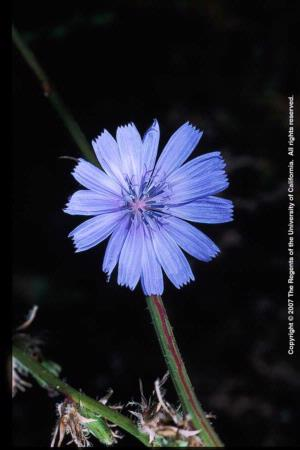
Just what is a weed? Some say that a weed is any plant growing where it is not wanted. But let's take a look at weeds from some different angles. Maybe they aren't always the nuisance we think they are.
Many so-called weeds are attractive, with verdant foliage (lambs quarters, English daisy), colorful flowers (chicory, scarlet pimpernel, day lily, and buttercup oxalis) or interesting growth patterns (plantain, willow herb and mallow). Others make lush groundcovers or turf (clover, common chickweed, Bermuda grass).
Some weeds provide children with great entertainment. Perhaps you remember blowing dandelion seed pods, making filigree “scissors,” sucking the sweet-sour stems of oxalis, stringing wild radish fruit necklaces or picking bouquets for doll parties and friends.
More importantly, and more usefully, weeds can communicate valuable information about the soil in which they grow. A happy weed can indicate what other types of plants would do well in that area, or what improvement a soil might need.
If you see yellow nutsedge, dock or foxtails, the site probably has soggy, swampy conditions on occasion. In that situation, ornamental willows, Japanese and Siberian iris, ligularia and dogwoods would do well, too.
Chicory, annual bluegrass, bindweed and chickweed indicate compacted soil. Planting a strong-rooted cover crop, such as white lupines or sweet clover, would help break up the soil and release nitrogen as well. Adding organic compost could also help aerate and lighten the soil.
Dandelions, sorrel, annual bluegrass and plantain prefer acidic soil, with pH below 7.0.Where those weeds do well, you can probably grow hydrangeas, blueberries, rhododendrons and azaleas, which also thrive in “sour” soil.
Alkaline soil, with a pH above 7.0,is hospitable to poppy, sagebrush and scarlet pimpernel, but also to choice ornamentals, such as lilac, lavender, dianthus and baby's breath.
Fertile soil supports chickweed and lambsquarters. The presence of redroot pigweed indicatesan abundance of nitrogen. Red clover suggests the soil is high in potassium, while wild mustard signals phosphorus. Heavy-feeding vegetables—corn, broccoli, lettuce, melons, squash, tomatoes and peppers—should grow well in such rich soil.
Your soil may have poor fertility if you see daisies, shepherd's purse or black medic. Not to worry. Many perennials, including coreopsis, salvia and stachys, flower better in lean soil. Legumes, beets, carrots, peas, radishes and sage tolerate low-fertility soils as well.
Besides indicating soil conditions, weeds can also improve the soil. Strong-rooted weeds like dock, dandelions and mallow push deeply into soil, opening air spaces and improving drainage. Shallow-rooted weeds like ground ivy, knotweed and purslane act as groundcover and help prevent erosion and soil crusting. Some weeds in the legume family, such as clover and black medic, add nitrogen that more desirable plants can use.
Weeds in the lawn can indicate what changes you need to make to grow healthy grass. Mow your lawn too low (shorter than one and one-half inches) and you encourage annual bluegrass, crabgrass and plantain. Low mowing can kill grass roots and invite the sunlightthat stimulates weed sprouting. Mowing higher encourages grass to develop deeper, drought-resistant roots.
Water too much or too little and you may find clover, crabgrass or annual bluegrass in your lawn. For most turf grasses, one deep weekly watering (about one inch) in the early morning is best. Poor drainage invites ground ivy, knotweed and plantains to take hold, but once your lawn has established a deep root system, you won't need to water as much and drainage may be less of an issue.
Napa County Master Gardeners are offering two upcoming activities to help you work with your weeds:
Weed ID: Join Napa County Master Gardeners on Wednesday, April 23, from 3 p.m. to 5 p.m., at Connolly Ranch (address below) in Napa for “Wednesday Walk About.” Master Gardeners will focus on weed identification in their demonstration garden. Materials will be available to take home for identifying weeds in your own yard.
Workshop:Join Napa County Master Gardeners for “What's That Weed? What Does It Tell Me? How Do I Control It?” on Thursday, April 24, from 6 p.m. to 7:30 p.m., in the University of California Cooperative Extension office (address below).Learn to identify some of the most common garden weeds and what they can tell you about your garden. Knowing what weeds you have can help you discover clues about your garden microclimates and soil conditions.Online registration (credit card only)Mail in registration (cash or check only)
Master Gardeners are volunteers who help the University of California reach the gardening public with home gardening information. Napa County Master Gardeners ( http://ucanr.org/ucmgnapa/) are available to answer gardening questions in person or by phone, Monday, Wednesday and Friday, 9 a.m. to Noon, at the U. C. Cooperative Extension office, 1710 Soscol Avenue, Suite 4, Napa, 707-253-4143, or from outside City of Napa toll-free at 877-279-3065. Or e-mail your garden questions by following the guidelines on our web site. Click on Napa, then on Have Garden Questions? Find us on Facebook under UC Master Gardeners of Napa County.
Napa County Master Gardeners welcome the public to visit their demonstration garden at Connolly Ranch on Thursdays, from 10:00 a.m. until noon, except the last Thursday of the month. Connolly Ranch is at 3141 Browns Valley Road at Thompson Avenue in Napa. Enter on Thompson Avenue.